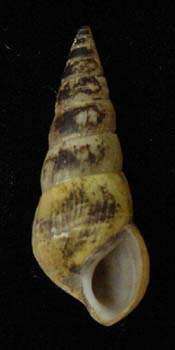Pleurocera
Pleurocera is a genus of freshwater snails with an operculum, aquatic gastropod mollusks in the family Pleuroceridae.[3]
| Pleurocera | |
|---|---|
 | |
| Apertural view of a shell of Pleurocera acuta | |
| Scientific classification | |
| Kingdom: | |
| Phylum: | |
| Class: | |
| (unranked): | |
| Superfamily: | |
| Family: | |
| Genus: | Pleurocera Rafinesque, 1818[1] |
| Synonyms[2] | |
|
Oxytrema Rafinesque, 1819 | |
Pleurocera is the type genus of that family.
Distribution
All members of the genus Pleurocera are native to eastern North America.[2]
Description
All of the species in this genus have thick-walled high-spired shells, and some attain a length of over 4 cm. The shape of the shell is elongate-conic or cylindrical.[2] The sculpture of the shell is often carinate or costate.[2] The shell of larger species sometimes develops sculpturing and a small siphonal canal or siphonal notch at the base of the aperture.[2]
Opercula are paucispiral and corneous, but may be vestigial in some species, not completely closing the aperture.
The soft parts of the animal usually have a gray or brown coloration, commonly speckled with orange. The similar genus Juga has a seminal receptacle, but Pleurocera has no seminal receptacle.[2]
Species
Species within the genus Pleurocera include: (brackets needs to be checked, authorities according to the IUCN Red List may be incorrect)
- Pleurocera acuta Rafinesque, 1831 - sharp hornsnail, type species of the genus Pleurocera[4]
- Pleurocera alveare Conrad, 1834 - rugged hornsnail
- Pleurocera annulifera Conrad, 1834 - ringed hornsnail
- Pleurocera brumbyi I. Lea, 1852 - spiral hornsnail
- Pleurocera catenaria catenaria (Say, 1822)
- Pleurocera catenaria catenaria (Say, 1822) - synonyms: Pleurocera albanyensis (I. Lea, 1864), Pleurocera boykiniana (I. Lea, 1840), Pleurocera caelatura, Pleurocera christyi, Pleurocera darwini, Pleurocera interrupta (Haldeman, 1840), Pleurocera lecontiana, Pleurocera mutabilis, Pleurocera postelli, Pleurocera suturalis, Pleurocera viennaensis[5]
- Pleurocera catenaria dislocata (Ravenel, 1834)[6]
- Pleurocera corpulenta Anthony, 1854 - corpulent hornsnail
- Pleurocera curta Haldeman, 1841 - shortspire hornsnail
- Pleurocera foremani I. Lea, 1843 - rough hornsnail
- Pleurocera pyrenella Conrad, 1834 - skirted hornsnail
- Pleurocera showalteri I. Lea, 1862 - upland hornsnail
- Pleurocera walkeri Goodrich, 1928 - telescope hornsnail
- Pleurocera canaliculata (Say, 1821) - Silty hornsnail, synonyms: Pleurocera nobile[7]
- Species brought into synonymy
- Pleurocera costulatum Fuchs, 1870: synonym of † Goniochilus costulatus (Fuchs, 1870)
- Pleurocera kochii Fuchs, 1870: synonym of † Goniochilus kochii (Fuchs, 1870)
- Pleurocera radmanesti Fuchs, 1870: synonym of † Prososthenia radmanesti (Fuchs, 1870)
Ecology
Most species inhabit larger rivers.[2]
Pleurocera snails are dioecious.[2]
References
- Rafinesque (1818). Amer. mon. Mag. 3(5): 355.
- Dillon R. T. (2011). "Robust Shell Phenotype is a Local Response to Stream Size in the Genus Pleurocera (Rafinesque, 1818)". Malacologia 53(2): 265-277. doi:10.4002/040.053.0205.
- Neubauer, Thomas A. (2014). Pleurocera Rafinesque, 1818. Accessed through: World Register of Marine Species at http://www.marinespecies.org/aphia.php?p=taxdetails&id=820483 on 2014-11-25
- Melville R. V. (1981). "Opinion 1195. Pleurocera Rafinesque, 1818 (Gastropoda): The type species is Pleurocerus acutus Rafinesque in Blainville, 1824". Bulletin of Zoological Nomenclature 38: 259–265.
- "Pleurocera catenaria catenaria (Say 1822)". FWGNA: Freshwater Gastropods of North America, accessed 21 February 2013.
- "Pleurocera catenaria dislocata (Ravenel 1834)". FWGNA: Freshwater Gastropods of North America, accessed 21 February 2013.
- "Pleurocera canaliculata (Say 1821)". FWGNA: Freshwater Gastropods of North America, accessed 21 February 2013.
External links
